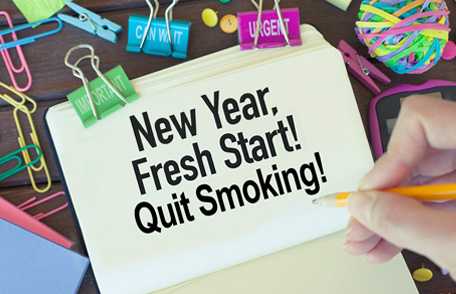Countdown to Quitting
 Make 2017 your year to quit
Make 2017 your year to quit
Making a New Year’s resolution on January 1 can be one of the most exciting things about ending one year and starting the next. If you’re one of the nearly 7 in 10 U.S. smokers who want to quit, why not make a resolution to get started in 2017? Smoking is the leading cause of preventable disease and death in the United States, and quitting now can cut your risk and leave you feeling stronger and healthier.
Beatrice, a former cigarette smoker living in New York, made the decision to quit in 2010. She had smoked regularly since the age of 13 and finally quit for good after 25 years of smoking. Beatrice’s greatest motivator was her son, who wrote her a letter at age 11 asking her to quit. “When I was going through the process of quitting, that letter was very motivating for me,” she says. She encourages anyone who wants to quit smoking to do it—and to get help. Beatrice found additional support online from friends who encouraged her to stay smoke-free, as well as from her family. “You’re going to need support, because it’s not always easy,” she says, “but the main thing is, you really have to want to quit.” In the video titled, “ I told everyone I stopped smoking ,” from CDC’s Tips From Former Smokers TM campaign, Beatrice describes some of the quitting techniques that helped her recognize and avoid her smoking triggers. Although it was hard to do, by making a plan and sticking to it, she beat her addiction to cigarettes and stopped smoking for good.
Develop a Quit Plan

Beatrice quit smoking in 2010.
Like Beatrice, most smokers who want to quit try several times before they succeed, but you can take steps that can improve your chances. Planning ahead is a major part of successfully quitting smoking. Smokefree.gov offers details on how to create an effective quit plan , including:
- Picking a quit date. Starting the new year smokefree is a great idea.
- Letting loved ones know you’re quitting so they can support you.
- Listing your reasons to quit smoking.
- Figuring out what triggers make you want to smoke so you can avoid them, especially during the early days.
- Having places you can turn to for help right away, including the free resources listed below.
Use Free, Effective Resources
There are many free resources for people trying to quit smoking:
- 1-800-QUIT-NOW (1-800-784-8669) or 1-855-DÉJELO-YA (1-855-335-3569) (for Spanish speakers). This free service offers a lot of resources, including coaching, help with making a quit plan, educational materials, and referrals to other resources where you live.
- Smokefree TXT. This free 24/7 texting program sends encouragement, advice, and tips to help smokers quit smoking for good. To get started, just text QUIT to 47848, answer a few questions, and you’ll start receiving messages.
- Online help. This Tips From Former Smokers web page provides helpful online quit resources.
- Smokefree App. The QuitGuide is a free app that tracks cravings, moods, slips, and smokefree progress to help you understand your smoking patterns and build the skills needed to become and stay smokefree.

Talk to your health care provider about medicines that may help you quit smoking.
Find a Medication That’s Right for You
You can also talk to your health care provider about medicines that may help you quit smoking.
Because cigarettes contain nicotine, a powerfully addictive drug, when you first quit, your body may feel uncomfortable until it adjusts. This is known as withdrawal, and there are medications that can help lessen this feeling and the urge to smoke. Studies show that smokers who use medicine to help control cravings, along with coaching from a quitline, in a group, or from a counselor, are much more likely to succeed than those who go it alone. Talk to your doctor, pharmacist, or other health care provider before using any medications if you:
- Are pregnant or nursing
- Have a serious medical condition
- Are currently using other medications
- Are younger than 18
Many options are available if you are considering using medications to help you quit smoking. The most common smoking medications are nicotine replacement therapies (NRTs), which give your body a little of the nicotine that it craves without the harmful chemicals found in burning cigarettes. Examples of Food and Drug Administration-approved NRTs that you can buy over the counter include:
- Nicotine patches
- Nicotine gum
- Nicotine lozenges
NRTs that need a prescription include nicotine inhalers and nasal spray. Your doctor can also prescribe medication that does not contain nicotine (such as bupropion or varenicline) to help you quit smoking completely.
Although quitting was difficult for Beatrice, and she had made several attempts, today she has more energy than when she smoked. You too can begin a healthier life in 2017 by making a quit plan, using free resources, and finding a smoking medication that’s right for you. Even if you don’t smoke yourself, you can use this article to help a friend or family member become smokefree in 2017!
More Information
- Quitting Smoking (CDC fact sheet)
- What You Need to Know About Smoking [811 KB] (CDC fact sheet)
- Let’s Make the Next Generation Tobacco-Free: Your Guide to the 50th Anniversary Surgeon General’s Report on Smoking and Health [12 MB] (consumer guide)
- Page last reviewed: December 30, 2016
- Page last updated: December 30, 2016
- Content source:
- National Center for Chronic Disease Prevention and Health Promotion, Office on Smoking and Health
- Page maintained by: Office of the Associate Director for Communication, Digital Media Branch, Division of Public Affairs




 ShareCompartir
ShareCompartir